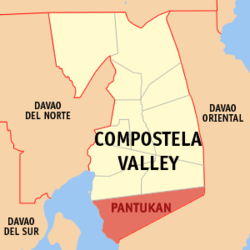Pantukan, Compostela Valley
| Pantukan | |
|---|---|
| Municipality | |
 Map of Compostela Valley with Pantukan highlighted | |
.svg.png) Pantukan Location within the Philippines | |
| Coordinates: 07°09′N 125°57′E / 7.150°N 125.950°ECoordinates: 07°09′N 125°57′E / 7.150°N 125.950°E | |
| Country | Philippines |
| Region | Davao (Region XI) |
| Province | Compostela Valley |
| District | 2nd district of Compostela Valley |
| Established | November 13, 1937 |
| Barangays | 13 |
| Government[1] | |
| • Mayor | Roberto M.Yugo MPA (Liberal) |
| • Vice Mayor | Hajarah Ranain Divinagracia (Aksyon Demokratiko) |
| Area[2] | |
| • Total | 533.11 km2 (205.83 sq mi) |
| Population (2010)[3] | |
| • Total | 79,067 |
| • Density | 150/km2 (380/sq mi) |
| Time zone | PST (UTC+8) |
| ZIP code | 8809 |
| Dialing code | 87 |
| Income class | 1st |
Pantukan is a first class municipality in the province of Compostela Valley, Philippines. According to the 2010 census, it has a population of 79,067 people.[3]
Barangays
Pantukan is politically subdivided into 13 barangays.[2]
- Bongabong
- Bongbong
- P. Fuentes
- Kingking (Pob.)
- Magnaga
- Matiao
- Napnapan
- Tagdangua
- Tambongon
- Tibagon
- Las Arenas
- Araibo
- Tagugpo
History
In 1914, Governor General Charles Yeater declared Pantukan a Municipal District. Sangui, a Mansaka, was appointed president. A year after, he was replaced by Bancas Mansaka. On 13 November 1936, President Manuel L. Quezon declared it a regular municipality, therefore becoming the oldest local government unit in ComVal province. Teodoro Fuentes was appointed its first Alkalde. Juan Caballero Sr. was its first elected Mayor. From then up to the present, the elected mayors were: Graciano Arafol (1952-1959), Diosdado Basanez (1960-1963), Celso Sarenas (1964-) with Juan Caballero, Jr. as OIC (1986-1987), Jovito Derla (1988-1992), Juan Caballero, Jr. (1992-1995), Jovita Derla (1995-2004), Tok Sarenas (2004-2013), and Roberto Yugo (2013-).[4]
Demographics
| Population census of Pantukan | ||
|---|---|---|
| Year | Pop. | ±% p.a. |
| 1990 | 46,300 | — |
| 1995 | 56,780 | +3.90% |
| 2000 | 61,801 | +1.83% |
| 2007 | 69,656 | +1.66% |
| 2010 | 79,067 | +4.72% |
| Source: National Statistics Office[3][5] | ||
Economy
The town is primarily dependent on mining but agriculture thrives in communities within its boundary. While small scale mining operates in the town, a large mining operator has been granted permit to explore gold in the area. Gold deposits in Barangay Kingking alone is estimated to be at 10.3 million ounces with copper deposits of 5.4 billion pounds. Nationwide Development Corporation (Nadecor) holds the Mineral Production Sharing Agreement (MPSA) for the Kingking mine site.
References
- ↑ "Official City/Municipal 2013 Election Results". Intramuros, Manila, Philippines: Commission on Elections (COMELEC). 1 July 2013. Retrieved 5 September 2013.
- 1 2 "Province: COMPOSTELA VALLEY". PSGC Interactive. Makati City, Philippines: National Statistical Coordination Board. Retrieved 21 April 2014.
- 1 2 3 "Total Population by Province, City, Municipality and Barangay: as of May 1, 2010" (PDF). 2010 Census of Population and Housing. National Statistics Office. Retrieved 21 April 2014.
- ↑ Noel Refamonte (2000). parokya ni san jose souvenir program. Missing or empty
|title=(help) - ↑ "Province of Compostela Valley". Municipality Population Data. LWUA Research Division. Retrieved 22 April 2014.
External links
 |
Mabini / Maragusan |  | ||
| Samal, Davao del Norte / Davao Gulf | |
Caraga, Davao Oriental | ||
| ||||
| | ||||
| Banaybanay, Davao Oriental |